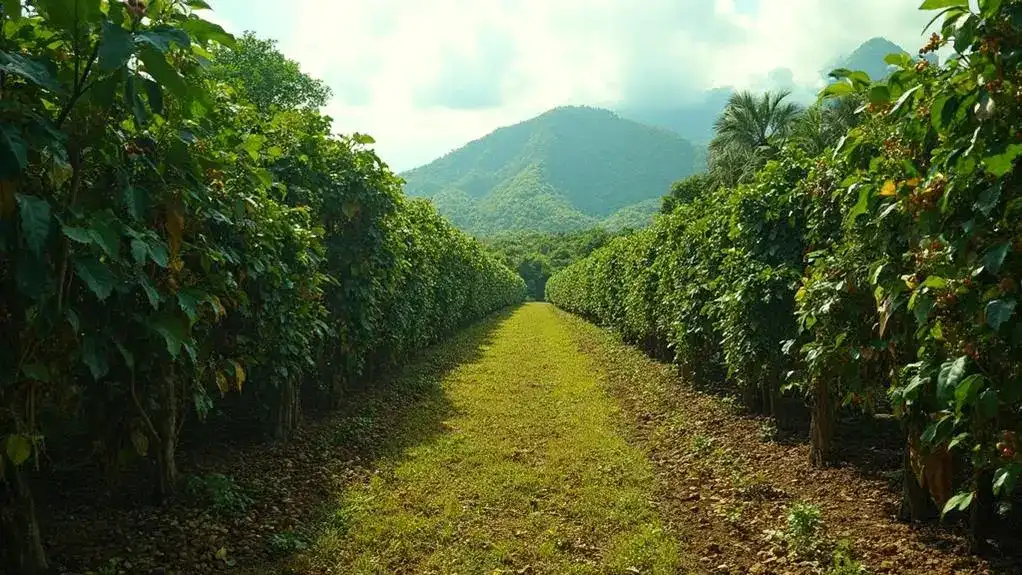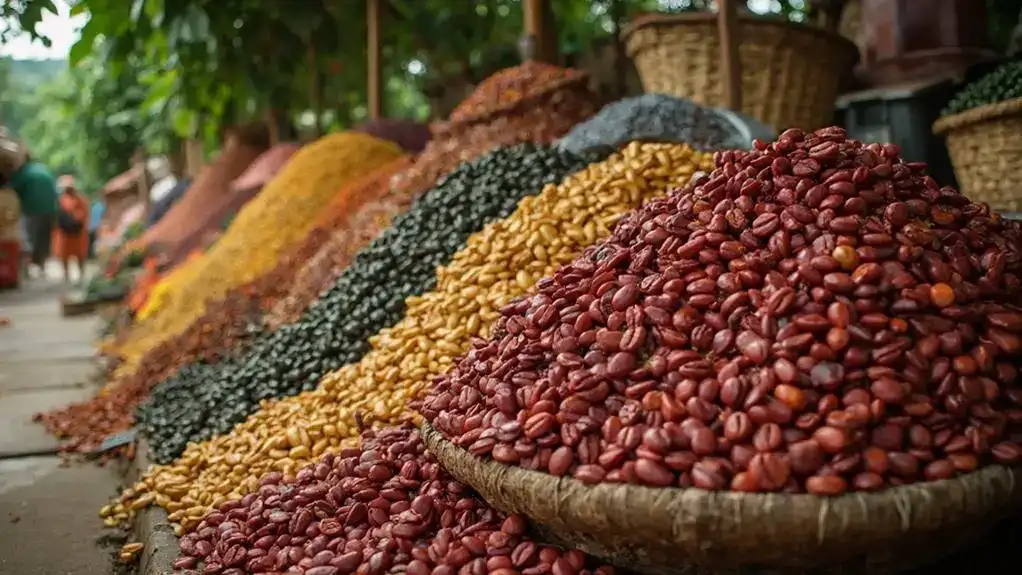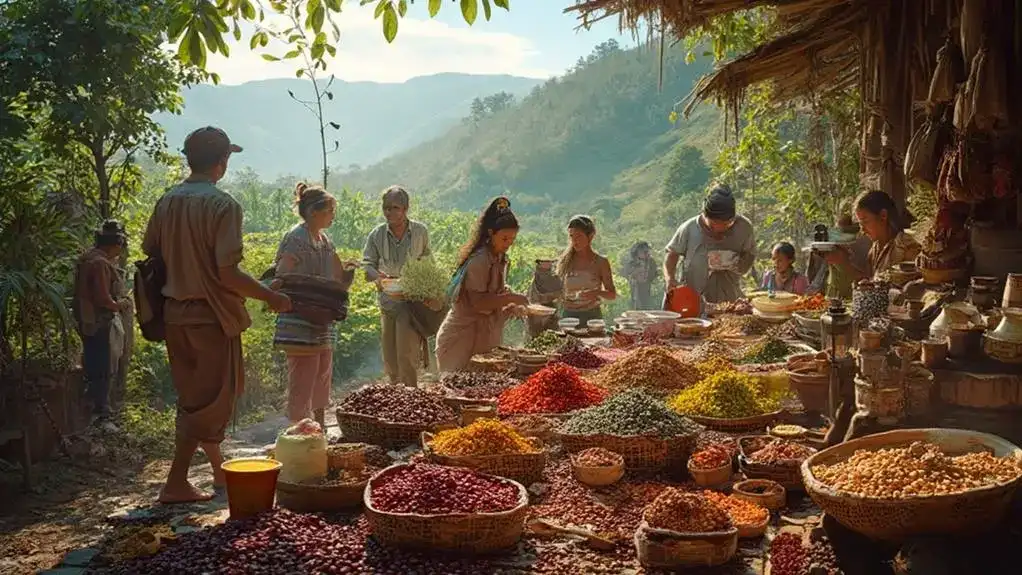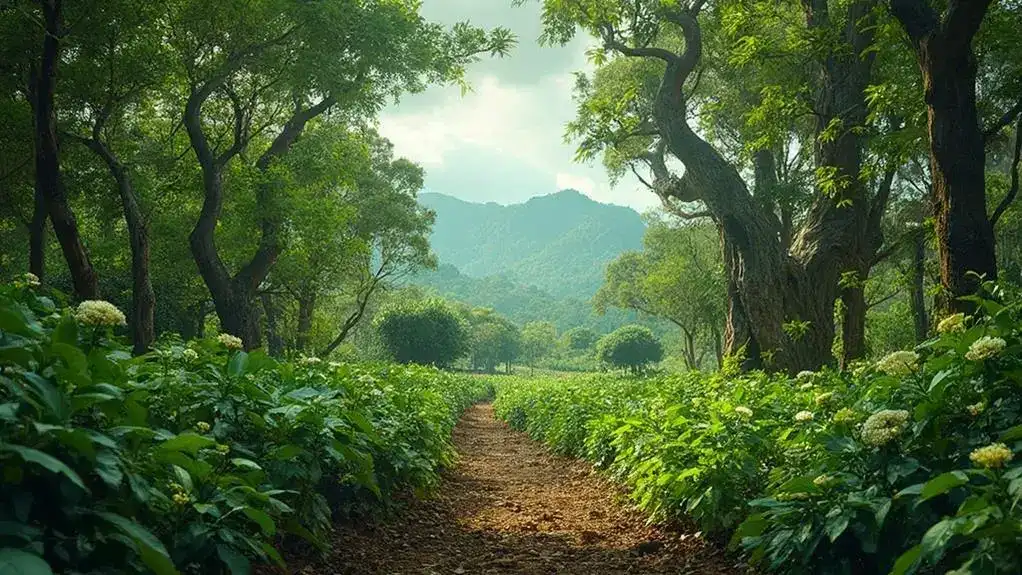When you compare Liberica and Arabica coffee, you encounter two distinct flavor profiles. Liberica is known for its bold, earthy, and intense notes, often featuring high acidity and a unique woody taste. It’s typically best enjoyed in dark roasts. In contrast, Arabica provides a smoother experience with sweet, balanced flavors complemented by fruity and floral undertones. It’s versatile, excelling across various brewing methods, from espresso to pour-over. Liberica faces challenges in cultivation and market presence, while Arabica enjoys global popularity and higher economic viability. Discover more about the nuances of these coffee varieties and their cultural significance.
What are the Unique Flavor Profiles of Liberica and Arabica Coffee?

When it comes to flavor, Liberica and Arabica coffee offer distinct experiences. You might find Liberica’s bold, woody notes intriguing, while Arabica’s smooth, fruity profile could be more to your taste.
Here are some key differences to evaluate:
- Liberica’s Flavor: Bold, earthy, and intense with a pronounced acidity.
- Arabica’s Flavor: Sweet, balanced, and complex with fruity and floral undertones.
- Brewing Impact: Liberica shines in dark roasts; Arabica is versatile across various brewing methods.
- Cultural Connection: Liberica is often linked to Southeast Asian traditions, whereas Arabica enjoys global appeal.
What Sets Liberica Coffee’s Flavor Apart?
When you taste Liberica coffee, you’ll notice its bold, woody, and earthy notes that set it apart from Arabica.
This coffee variety also boasts a pronounced acidity and bitterness, creating a more intense flavor experience.
In contrast, Arabica offers a smoother profile, marked by sweet, fruity, and floral undertones, showcasing the distinct characteristics of each type.
The Woody and Earthy Notes of Liberica
Liberica coffee stands out with its unique woody and earthy notes, offering a flavor profile that sets it apart from the more commonly enjoyed Arabica.
Its bold intensity and robust flavor feature distinct woody undertones and an earthy aroma.
In a taste comparison, you’ll notice its unique characteristics and flavor complexity, making Liberica a distinctive choice for those seeking something different in their coffee experience.
Exploring the Acidity and Bitterness in Liberica Coffee
The unique profile of Liberica coffee is marked by its pronounced acidity and distinct bitterness, setting it apart from Arabica.
To understand its flavor:
- High acidity balances the boldness.
- Bitterness impact can be overwhelming.
- Dark roasting enhances these traits.
- Unique tropical notes emerge in lighter roasts.
These elements create a distinctive cup, appealing to those who appreciate intensity in their coffee experience.
The Distinctive Taste of Arabica Coffee
When you taste Arabica coffee, you’ll notice its signature sweetness and balance that set it apart.
This variety often features delightful fruity and floral undertones that enhance its complexity, making each sip enjoyable.
Understanding these unique flavor profiles can help you appreciate why Arabica is a favorite among coffee lovers.
Sweetness and Balance in Arabica Coffee
Arabica coffee stands out for its remarkable sweetness and balance, making it a favorite among coffee enthusiasts.
Here are four key arabica characteristics that enhance its appeal:
- Mild sweetness that delights the palate.
- Well-rounded flavor profile with smoothness.
- Balanced acidity that complements its sweetness.
- Versatile roasting options to highlight different flavors.
These elements create a harmonious coffee experience that many cherish.
Fruity and Floral Undertones of Arabica
Building on the sweetness and balance of Arabica coffee, its fruity and floral undertones further elevate its flavor profile.
You’ll notice:
- Fruity notes like cherry and berry, adding complexity.
- Floral aromas reminiscent of jasmine and lavender, enhancing aroma.
- A smooth texture that complements its sweetness.
- A revitalizing acidity that brightens each sip.
These characteristics make Arabica a favorite among coffee enthusiasts.
Roasting Techniques for Liberica and Arabica Coffee

When it comes to roasting Liberica and Arabica coffee, the techniques can greatly impact their flavors.
You’ll find that Liberica is often roasted darker, amplifying its boldness, while Arabica allows for a range of roasting levels to showcase its sweet and fruity notes.
Here are some key points to take into account:
- Liberica Roasting: Typically roasted dark to highlight woody and smoky flavors.
- Arabica Roasting: Can be roasted light to dark, allowing for diverse flavor profiles.
- Flavor Enhancement: Darker roasts of Liberica reduce bitterness but enhance intensity.
- Brewing Compatibility: Each roast level affects the best brewing methods to use for ideal taste.
How is Liberica Coffee Roasted?
When it comes to roasting Liberica coffee, traditional methods often favor a dark roast to highlight its bold, woody flavors.
However, you might find that experimenting with lighter roasts can reveal unique tropical fruit notes and lessen the bitterness.
In contrast, roasting Arabica allows for a wider range of profiles, from light and fruity to dark and chocolatey, making each approach distinct.
The Traditional Dark Roast of Liberica
Although many coffee enthusiasts are familiar with various roasting techniques, the traditional dark roast of Liberica stands out due to its bold and intense flavor profile.
Here’s what you should know about Liberica roasting:
- It enhances the woody and smoky notes.
- High temperatures increase bitterness.
- The result is a robust, full-bodied cup.
- Liberica intensity is best appreciated with a controlled brewing method.
Experimenting with Lighter Roasts for Liberica
While traditional dark roasts of Liberica highlight its bold, woody flavors, experimenting with lighter roasts can reveal a different side of this unique coffee.
When engaging in light roast experimentation, consider:
- Enhanced tropical fruit notes
- Reduced bitterness
- Increased acidity
- Unique flavor exploration
These factors can transform your Liberica experience, showcasing its versatility and inviting a broader appreciation of its complex profile.
Arabica Coffee Roasting Techniques
When you roast Arabica coffee, you have the flexibility to explore a wide range of flavor profiles.
Common roast levels include light, medium, and dark, each highlighting different characteristics, from fruity and floral notes to deep chocolatey undertones.
Exploring Arabica’s Wide Range of Flavor Profiles
Arabica coffee offers a remarkable range of flavors that can be enhanced through various roasting techniques.
This Arabica versatility allows you to experience diverse taste profiles, such as:
- Light roasts highlighting fruity notes.
- Medium roasts balancing sweetness and acidity.
- Dark roasts introducing chocolate and caramel flavors.
- Specialty roasts focusing on unique regional characteristics.
Each technique reveals distinct Arabica flavor nuances, inviting exploration.
Common Roast Levels for Arabica Coffee
Exploring the various roast levels for Arabica coffee reveals how roasting can greatly influence its flavor profile.
Understanding common roast levels can help you identify your roasting preferences. Here are four key levels:
- Light Roast: Fruity and vibrant.
- Medium Roast: Balanced sweetness.
- Medium-Dark Roast: Rich, chocolatey notes.
- Dark Roast: Bold, intense flavors.
Each level offers a unique tasting experience, enhancing your appreciation for Arabica.
How Do Cultivation and Yield Differ Between Liberica and Arabica Coffee?

When you compare the cultivation and yield of Liberica and Arabica coffee, you’ll notice some significant differences. Liberica grows on larger trees and faces challenges in harvesting, resulting in lower yields and limited availability. In contrast, Arabica thrives in higher altitudes and is more economically viable due to its higher yield and global demand.
| Cultivation Aspect | Liberica Coffee |
|---|---|
| Tree Size | Larger trees, harder to harvest |
| Yield | Lower yield, less commonly grown |
| Economic Viability | Less economically viable |
| Cultivation Aspect | Arabica Coffee |
| Tree Size | Smaller trees, easier to harvest |
| Yield | Higher yield, widely cultivated |
| Economic Viability | More economically viable |
Growing and Harvesting Liberica Coffee
When you consider growing Liberica coffee, you’ll notice its unique characteristics, such as its large tree size and distinct flavor profile.
However, these traits come with challenges, especially during the harvesting process, which can be more difficult compared to Arabica.
Understanding these differences in cultivation and yield can help you appreciate the rarity and complexity of Liberica coffee.
The Unique Growth Characteristics of Liberica
Cultivating Liberica coffee presents unique challenges that set it apart from Arabica. Here are some key points to reflect upon:
- Liberica tree size: Larger trees require more space and care.
- Liberica cultivation: It’s less common due to specific climate needs.
- Liberica harvesting: The process is labor-intensive.
- Liberica market challenges: Limited availability affects its specialty coffee status.
Challenges in Harvesting Liberica Coffee
Although Liberica coffee offers a unique flavor experience, harvesting it poses significant challenges that differ greatly from those associated with Arabica.
Here are some key harvesting difficulties you might encounter:
- Larger tree size complicates access.
- Uneven ripening leads to labor challenges.
- Lower yield makes it less economically viable.
- Manual harvesting is often required, increasing labor costs.
These factors make Liberica cultivation more demanding.
Arabica Coffee Cultivation and Economic Impact
When it comes to coffee cultivation, Arabica beans stand out due to their higher yield potential compared to Liberica.
This higher productivity not only makes Arabica more economically viable but also allows it to meet global demand effectively.
Understanding these differences in cultivation and yield is essential for grasping the broader economic impact of each coffee type.
Higher Yield Potential of Arabica Coffee
Arabica coffee stands out in the market due to its higher yield potential, which profoundly impacts its economic viability.
The advantages of Arabica yield include:
- Increased production per hectare.
- Greater global demand for quality coffee.
- Higher profitability for farmers.
- Enhanced sustainability in cultivation.
These economic advantages make Arabica a preferred choice among growers and contribute considerably to the coffee industry.
Why Arabica is More Economically Viable
One key reason Arabica coffee is more economically viable than Liberica lies in its cultivation practices and yield potential.
Here are some economic factors to take into account:
- Higher yield reduces cultivation costs.
- Robust supply chain supports global distribution.
- Strong consumer demand drives pricing strategies.
- Favorable market trends enhance export opportunities.
These elements collectively guarantee Arabica meets quality standards while overcoming export challenges effectively.
Market Availability: Liberica vs Arabica Coffee

When it comes to market availability, Liberica coffee is quite rare, making up only a small portion of global production. In contrast, Arabica coffee dominates the market due to its widespread popularity and versatile flavor profile. Let’s take a closer look at how these two types stack up against each other.
| Coffee Type | Availability | Market Presence |
|---|---|---|
| Liberica | Rare, mostly in Southeast Asia | Specialty markets |
| Arabica | Widespread globally | Dominates coffee market |
Availability and Market Presence of Liberica Coffee
Liberica coffee is quite rare in the global market, making up a small fraction of coffee production, primarily found in Southeast Asia.
Many people often confuse Liberica with Robusta coffee due to their robust flavors, but they’re distinctly different in taste and cultivation.
Understanding these differences can help you appreciate the unique qualities of Liberica while recognizing its limited availability compared to the more common Arabica.
The Scarcity of Liberica in the Global Market
The scarcity of Liberica coffee in the global market makes it a rare find for enthusiasts and connoisseurs alike.
- Liberica accounts for only a small percentage of global coffee production.
- Market challenges include difficult harvesting and low yield.
- Consumer awareness is limited compared to Arabica.
- Its cultural significance in Southeast Asia adds to its unique appeal.
Common Confusions with Robusta Coffee
Many coffee lovers often confuse Liberica with Robusta, primarily due to their shared status as lesser-known varieties compared to Arabica.
Here are some common liberica misconceptions and robusta differences:
- Liberica has a unique flavor profile, unlike Robusta.
- Robusta is more bitter and has higher caffeine.
- Liberica is rarer and less commercially available.
- Both offer distinct brewing experiences.
Widespread Availability of Arabica Coffee
Arabica coffee is known for its global popularity and widespread availability, making it the go-to choice for many coffee drinkers.
Its smooth flavor and versatility in brewing methods drive high demand, ensuring it’s found in cafes and stores worldwide.
This extensive market presence is largely due to Arabica’s economic viability, cultivated across many regions, which allows it to meet the needs of consumers everywhere.
Global Popularity and Market Presence of Arabica
When it comes to global coffee consumption, there’s no denying that Arabica stands out as the most popular choice among coffee lovers.
Its market presence is shaped by:
- Arabica market dynamics driving higher demand.
- Arabica consumer preferences leaning towards quality.
- Arabica trade trends influencing international sales.
- Arabica pricing fluctuations reflecting its premium status.
These factors collectively highlight Arabica’s dominance in the coffee landscape.
Why Arabica is Widely Available
With its widespread cultivation and strong market presence, Arabica coffee is readily available in various forms worldwide.
The Arabica market dynamics contribute to its abundance, while Liberica rarity reasons limit its presence. Key factors include:
- Higher yield and economic viability.
- Global demand and popularity.
- Diverse flavor profiles for consumers.
- Cultivation across multiple regions.
This combination guarantees Arabica remains accessible to coffee lovers everywhere.
What are the Best Brewing Methods for Liberica and Arabica Coffee?

When you’re brewing Liberica coffee, you’ll want to use methods that highlight its bold flavors, like the French press. On the other hand, Arabica’s versatility allows for a variety of brewing techniques, each enhancing different flavor notes. Here’s a quick comparison of the best methods for both types of coffee.
| Coffee Type | Best Brewing Methods | Flavor Notes Highlighted |
|---|---|---|
| Liberica | French Press | Bold, woody, earthy |
| Arabica | Espresso, Pour-Over, French Press | Fruity, floral, balanced |
How to Brew Liberica Coffee for Best Results
When brewing Liberica coffee, it’s important to choose methods that highlight its unique, bold flavors.
While traditional brewing techniques can enhance its profile, cold brew isn’t the best option.
Here are some effective brewing methods you might consider:
- French Press – This method allows for a fuller extraction of Liberica’s intense flavors.
- Pour-Over – It offers control over the brewing process, letting you adjust water temperature and flow.
- AeroPress – This versatile method can create a strong cup while balancing the boldness.
- Drip Coffee Maker – A standard option that can work well with careful adjustments to the coffee-to-water ratio.
Effective Brewing Methods for Liberica
Brewing Liberica coffee effectively requires an understanding of its bold flavors and unique characteristics.
To achieve ideal flavor extraction, consider these brewing techniques:
- Use a French press for a fuller body.
- Opt for a coarser grind to balance intensity.
- Adjust the coffee-to-water ratio to suit your taste.
- Experiment with brewing time to enhance complexity.
These methods highlight Liberica’s robust nature.
Why Liberica May Not Be Ideal for Cold Brew
Cold brew may not be the best choice for Liberica coffee due to its bold, intense flavors and high acidity.
Here are some Liberica cold brew challenges you might face:
- Overpowering bitterness.
- Reduced flavor complexity.
- Difficulty balancing acidity.
- Limited brewing flavor intensity.
For ideal results, consider brewing methods like French press or pour-over to highlight Liberica’s unique characteristics.
Brewing Arabica Coffee: Techniques and Preferences
When brewing Arabica coffee, you’ll appreciate its versatility and the range of techniques you can use to enhance its flavor.
From espresso to pour-over, each method brings out different qualities, so it’s good to explore what suits your taste best.
Here are some popular brewing preferences for Arabica coffee:
- Espresso – Ideal for a rich, concentrated shot with bold flavors.
- Pour-over – Offers control over brewing time and water temperature for a clean taste.
- French Press – Produces a full-bodied cup, highlighting the coffee’s complexity.
- Cold Brew – Creates a smooth, mellow flavor, perfect for invigorating iced coffee.
Versatility in Brewing Arabica Coffee
For Arabica coffee enthusiasts, the options for brewing are as diverse as the flavors it offers.
Arabica adaptability shines through in various methods, each bringing unique characteristics to the forefront.
Consider these top techniques for Arabica brewing:
- Espresso
- Pour-over
- French press
- Cold brew
These methods allow you to explore the full spectrum of Arabica’s rich complexities and smooth profiles.
Common Brewing Preferences for Arabica
Exploring the best brewing methods for Arabica coffee can elevate your coffee experience greatly.
Here are some common preferences:
- Pour-over: Enhances clarity and flavor.
- Espresso: Offers a rich, concentrated brew.
- French Press: Provides a full-bodied texture.
- Cold Brew: Results in a smooth, less acidic drink.
Using quality sourcing methods and brewing equipment can further enhance the unique notes of Arabica.
Cultural Significance of Liberica vs Arabica Coffee

When you consider the cultural significance of coffee, Liberica and Arabica tell two distinct stories.
While Liberica is deeply rooted in Southeast Asian traditions, particularly in the Philippines, Arabica has carved out a global identity.
Here are a few points to reflect on:
- Liberica, known as Barako in the Philippines, is often enjoyed black or sweetened, showcasing local customs.
- Arabica is synonymous with specialty coffee culture, celebrated worldwide for its superior quality.
- The unique flavor profiles of both coffees reflect their cultural contexts and preferences.
- Each coffee type fosters community and tradition in different regions, influencing social interactions and rituals.
The Cultural Importance of Liberica Coffee in Southeast Asia
Liberica coffee holds a special place in the cultural landscape of the Philippines, where it’s affectionately known as Barako.
You’ll often find it served black or sweetened, reflecting local traditions and preferences.
This unique coffee not only showcases regional flavors but also connects people to their heritage, making it a significant part of daily life.
Liberica’s Popularity in the Philippines
In the heart of the Philippines, Liberica coffee holds a special place in local culture, cherished for its unique flavor and rich history.
Its popularity stems from:
- Liberica heritage and Barako significance in coffee traditions.
- Philippine coffee festivals celebrating local varieties.
- Diverse regional variations enhancing flavor appreciation.
- Strong local consumption patterns reflecting cultural traditions.
Together, these elements showcase Liberica’s essential role in Filipino life.
Traditional Serving Styles of Liberica Coffee
Coffee lovers in the Philippines often enjoy Liberica in traditional ways that highlight its bold flavors and cultural roots.
Here are some common practices:
- Traditional preparation: Brewed strong, usually using a French press.
- Serving temperatures: Typically served hot to enhance its aroma.
- Flavor pairings: Often enjoyed with local pastries or sweeteners like sugar and condensed milk.
- Cultural rituals: Shared during family gatherings and special occasions, reflecting local customs.
Arabica Coffee’s Global Cultural Impact
Arabica coffee’s global cultural impact is significant, as it’s closely tied to the specialty coffee movement that values quality and unique flavor profiles.
Consumers worldwide often prefer Arabica for its smoothness and complexity, making it a staple in cafes and homes alike.
This preference not only shapes coffee culture but also influences how coffee is grown, marketed, and consumed on a global scale.
Arabica’s Association with Specialty Coffee Culture
While many coffee enthusiasts savor the rich flavors of various beans, Arabica stands out as the backbone of specialty coffee culture globally.
Its significance can be seen in:
- Higher quality standards in production.
- Emphasis on unique flavor profiles.
- Adoption of sustainable farming practices.
- Strong consumer trends favoring artisanal brewing.
Arabica’s influence shapes the specialty coffee landscape, making it a favorite among discerning consumers.
Global Consumer Preferences for Arabica
In today’s coffee culture, you’ll find that Arabica beans dominate consumer preferences worldwide.
Understanding Arabica consumer trends and flavor preferences helps illustrate why:
- Arabica’s smooth, complex taste appeals to many.
- It’s versatile across brewing methods.
- Higher caffeine content makes it stimulating.
- Global availability guarantees accessibility.
These factors contribute to Arabica’s reputation as the coffee of choice for enthusiasts everywhere.
How Do the Tastes of Liberica and Arabica Coffee Compare?

When you taste Liberica coffee, you’ll notice its bold, earthy flavor with strong woody notes, while Arabica offers a smoother, more complex experience with sweet and fruity undertones. Understanding these differences can help you choose the right coffee for your palate. Here’s a quick comparison to highlight their unique flavor profiles:
| Feature | Liberica Coffee | Arabica Coffee |
|---|---|---|
| Flavor Profile | Bold, woody, earthy | Smooth, balanced, sweet |
| Acidity | High acidity, intense | Mild acidity, well-balanced |
| Roasting Technique | Dark roast enhances boldness | Versatile roasting for varied flavors |
| Market Availability | Rare, mainly in Southeast Asia | Widespread, dominates global market |
| Cultural Significance | Important in Southeast Asia | Associated with specialty coffee culture |
What Does Liberica Coffee Taste Like?
When you taste Liberica coffee, you’ll notice its bold, dusty notes that create a unique, earthy experience.
Some lighter roasts even surprise you with tropical fruit undertones, adding complexity to its robust flavor.
In comparison, Arabica offers a smoother, sweeter profile, making it a favorite among many coffee drinkers.
The Bold and Dusty Notes of Liberica Coffee
With its bold, dusty notes, Liberica coffee offers a striking contrast to the smoother, more refined flavors of Arabica.
You’ll discover:
- Liberica’s intensity can be overpowering for some.
- Liberica’s uniqueness shines in its earthy profile.
- Liberica’s cultural significance is rooted in Southeast Asia.
- Liberica’s brewing challenges require careful methods to manage its boldness.
This makes it a niche choice among coffee lovers.
Discovering Tropical Fruit Undertones in Liberica
If you immerse yourself in the world of Liberica coffee, you’ll quickly notice its distinctive tropical fruit undertones, especially in lighter roasts.
These liberica nuances set it apart from other coffees. Here are a few notable flavors you might detect:
- Mango
- Pineapple
- Papaya
- Citrus
These fruity notes create a unique tasting experience that complements its bold profile.
The Smooth and Complex Taste of Arabica Coffee
When you taste Arabica coffee, you’ll notice its smooth, complex profile that often features sweet, fruity, and floral notes.
This balance makes it a favorite among coffee drinkers who appreciate a gentler flavor compared to the bold, earthy intensity of Liberica.
Understanding these common flavor descriptors helps clarify why many prefer Arabica for its overall smoothness and versatility.
Common Flavor Descriptors for Arabica Coffee
Arabica coffee stands out for its smooth and complex flavor profile, often described using a variety of enticing descriptors.
Here are some common flavor nuances you might encounter:
- Fruity notes, like berry or citrus.
- Floral aromas, reminiscent of jasmine or lavender.
- Nutty undertones, providing a warm richness.
- Sweetness that balances acidity, enhancing the overall experience.
These factors contribute greatly to consumer preferences and regional varieties in Arabica tasting.
Why Arabica is Preferred for its Smoothness
The smoothness of Arabica coffee is a key reason it’s favored by many coffee enthusiasts. Its unique characteristics enhance flavor preference, making it appealing.
Here’s why:
- Mild sweetness balances acidity.
- Fruity and floral notes create complexity.
- Lower bitterness enhances drinkability.
- Versatile brewing methods highlight distinct flavors.
These elements contribute to Arabica’s reputation for smoothness, solidifying its place in coffee culture.
How Does the Caffeine Content Differ in Liberica and Arabica Coffee?

When you’re choosing between Liberica and Arabica coffee, the caffeine content is an important factor to take into account. Liberica typically has caffeine levels ranging from 0.8% to 1.2%, while Arabica usually contains a bit more, from 0.8% to 1.4%. Let’s take a closer look at these differences in the table below.
| Coffee Type | Caffeine Content |
|---|---|
| Liberica | 0.8% – 1.2% |
| Arabica | 0.8% – 1.4% |
How Much Caffeine is in Liberica Coffee?
When it comes to caffeine content, Liberica coffee generally has lower levels compared to Arabica. This difference can impact your coffee experience, especially if you’re looking for a stronger kick.
Here are some key points to take into account:
- Liberica caffeine content typically ranges from 0.8% to 1.2%.
- Arabica caffeine levels are higher, usually around 0.8% to 1.4%.
- The lower caffeine in Liberica contributes to its bold, heavy flavor.
- If you prefer a milder coffee with less stimulation, Liberica might be the better choice.
Understanding the Lower Caffeine Levels in Liberica
Caffeine content plays an essential role in the overall coffee experience, and Liberica coffee offers a distinct profile compared to its more popular counterpart, Arabica.
Here’s what you should know:
- Liberica has lower caffeine levels (0.8% to 1.2%).
- This affects caffeine effects, leading to milder stimulation.
- Lower levels may enhance certain health benefits.
- It appeals to those seeking bold flavors without excessive caffeine.
Caffeine Levels in Arabica Coffee
When it comes to caffeine levels, Arabica coffee generally falls within a specific range that sets it apart from Liberica.
You’ll find that Arabica typically contains about 0.8% to 1.4% caffeine, which contributes to its popularity among coffee drinkers.
Let’s explore some key points about Arabica’s caffeine content:
- Arabica’s caffeine range: 0.8% to 1.4%
- Comparatively lower caffeine in Liberica: 0.8% to 1.2%
- Caffeine’s role in flavor perception
- Impact of caffeine on brewing preferences
The Standard Caffeine Range in Arabica
Understanding the caffeine content in Arabica coffee reveals its stimulating qualities, which can enhance your coffee experience.
Here’s a caffeine comparison that highlights its effects:
- Arabica typically contains 0.8% to 1.4% caffeine.
- Higher caffeine can boost alertness.
- Caffeine effects vary by individual.
- Stronger brews may intensify stimulation.
This knowledge helps you choose the right coffee based on your caffeine preferences.
Quality Perception: Liberica vs Arabica Coffee

When it comes to quality perception, Liberica coffee often gets a bad rap due to its intense, bitter flavor, appealing mainly to a niche market. In contrast, Arabica is celebrated for its smooth, complex flavors and low bitterness, making it the go-to choice for many coffee lovers. Let’s take a closer look at how these two coffees stack up regarding quality perception.
| Coffee Type | Quality Perception |
|---|---|
| Liberica | Often seen as lower quality; intense flavor appeals to niche drinkers. |
| Arabica | Regarded as high quality; known for smooth and complex flavors. |
How is Liberica Coffee Perceived in Terms of Quality?
When it comes to quality perception, Liberica coffee often gets labeled as a lower quality bean compared to Arabica.
Its bold, intense flavors and higher bitterness can turn some coffee enthusiasts away, making it appeal mainly to a niche market.
In contrast, Arabica is widely celebrated for its smooth, complex flavors, which contributes to its reputation as the preferred choice among coffee drinkers.
The Perception of Liberica as a Lower Quality Bean
Despite its unique flavor profile, Liberica coffee often faces a perception challenge as a lower quality bean compared to the more esteemed Arabica. This stems from several common misconceptions:
- Liberica’s bold taste is often mistaken for bitterness.
- Limited availability leads to assumptions about inferior quality.
- Cultural significance is overlooked.
- Roasting methods can mask its potential.
Understanding these factors can help clarify Liberica quality perceptions.
Arabica Coffee’s Reputation for Quality
When it comes to coffee quality, Arabica is often seen as the gold standard. Its smooth, complex flavors and low bitterness make it a favorite among coffee enthusiasts.
In contrast to Liberica, which tends to have a bold, intense taste, Arabica’s balanced profile appeals to a wider audience, establishing its reputation for superior quality.
Why Arabica is Considered Superior in Taste
Celebrated for its smooth and complex flavor profile, Arabica coffee is often regarded as the gold standard in the coffee world.
Its Arabica superiority stems from:
- Flavor complexity that intrigues coffee enthusiasts.
- Consistent quality standards that meet global demand.
- Balanced taste preferences with mild sweetness.
- Higher caffeine perception enhancing the sensory experience.
These elements contribute to Arabica’s esteemed reputation among coffee lovers.
Where Are Liberica and Arabica Coffee Grown?

When you’re curious about where Liberica and Arabica coffee are grown, you’ll find some striking differences. Liberica mainly thrives in Southeast Asia, while Arabica is cultivated in various regions around the world. Let’s break down the key growing areas for each type of coffee.
| Coffee Type | Key Growing Regions |
|---|---|
| Liberica | Philippines, Malaysia, parts of Africa |
| Arabica | Latin America, East Africa, parts of Asia |
Key Growing Regions for Liberica Coffee
When it comes to Liberica coffee, Southeast Asia and parts of Africa are its primary growing regions.
In countries like the Philippines and Malaysia, you’ll find this unique coffee thriving, often embraced for its bold flavors.
In contrast, Arabica coffee is widely cultivated across Latin America and East Africa, showcasing a diverse range of tastes influenced by their specific environments.
Southeast Asia and Africa: The Heartlands of Liberica
Where can you find the rich, bold flavor of Liberica coffee? You’ll discover it in Southeast Asia and parts of Africa, where its unique characteristics thrive.
Here are key points about Liberica:
- Liberica cultivation is prevalent in the Philippines and Malaysia.
- Liberica harvesting is challenging due to its large trees.
- The Liberica market remains niche.
- Liberica sustainability efforts are growing.
Arabica Coffee Growing Regions Around the World
When you think about Arabica coffee, Latin America probably comes to mind first, as it’s a major hub for its cultivation.
Countries like Brazil and Colombia are known for producing high-quality beans, thanks to their ideal growing conditions.
Beyond Latin America, you’ll also find Arabica thriving in East Africa and parts of Asia, each region adding its own unique flavor characteristics.
Popular Arabica Growing Areas: Latin America and Beyond
Across the world, Arabica coffee thrives in diverse regions, with Latin America being the most prominent growing area.
Key regions include:
- Colombia – Known for its smooth flavor and sustainable harvesting practices.
- Brazil – The largest producer, focusing on various coffee varieties.
- Mexico – Offers unique regional differences in taste.
- Costa Rica – Emphasizes flavor education and brewing innovations for specialty markets.
Conclusion
In the enchanting clash of Liberica and Arabica, each coffee type offers a unique journey for your taste buds. Liberica’s robust, rustic richness stands in stark contrast to Arabica’s sweet, sophisticated smoothness. By understanding the distinct flavors, cultivation challenges, and brewing methods, you can choose the perfect cup that aligns with your preferences. Whether you lean towards the bold or the smooth, both coffees promise a delightful experience that warms your soul with every sip.

